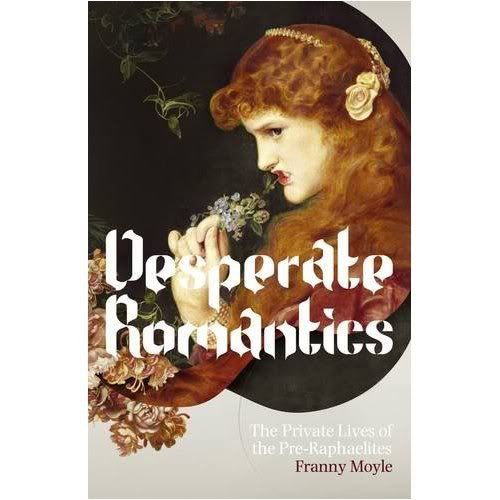
Franny Moyle's new book, Desperate Romantics, catalogues the lives and loves of the Pre-Raphaelites, while occasionally touching on their art. The book, which serves as the inspiration for the upcoming BBC miniseries of the same name, sounds like it will be a delight for those looking to dwell on the shallower aspects of the Pre-Raphaelite movement.
First, I will confess that the bohemian lifestyle of the Pre-Raphaelites has held a certain fascination for me ever since I first picked up Beth Russell's Traditional Needlepointand suddenly found myself entranced by the beauty of Morris and Rossetti's art and the sordid details of their personal lives. Whether for good or ill, the countless affairs, intrigues, love triangles and suicides that pepper the Pre-Raphaelite movement have undeniably added to their allure.
It still seems a shame that the book ignores the Pre-Raphaelites' art almost entirely, in favour of tabloid coverage of their exploits. There is so much more to the Pre-Raphaelite vision than sultry models and randy artists. William Morris himself was a fascinating man with beautiful ideas that are still pertinent today. The same is also true for the inspiring John Ruskin, who is sidelined as a mere deviant in Moyle's work. In her defence, however, I notice that Moyle is a television producer, which probably explains her conviction that sex is the best way to sell art. And perhaps she's right. It certainly worked for me. Today my interest in the Pre-Raphaelites goes far beyond their sordid personal lives, but in the beginning, their fascinating lives were instrumental in drawing me into their world.
For more information, read the Times review of Desperate Romantics
Wednesday, January 14, 2009
Desperate Romantics by Franny Moyle
Posted by
Margaret
at
10:28 AM
8
comments
![]()
![]()
Labels: books, jane morris, news, rossetti, ruskin, william morris
Tuesday, September 9, 2008
Astarte Syriaca
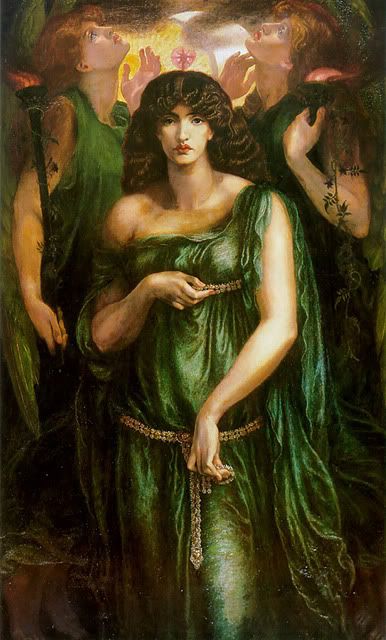
Painted between 1875 and 1877, Astarte Syriaca was originally entitled "Venus Astarte," in honour of the Syrian Love Goddess. Rossetti composed the painting on an immense six-foot (1.83 m) canvas, so that it was long enough for a full-length portrait. This is probably the most "revealing" portrait of Jane Morris, and its composition was partially based on Botticelli's The Birth of Venus.
The painting drew criticism when it was displayed, due to its erotic content. Victorian audiences were shocked by its overt sensuality. Venus' hands are positioned to draw attention to her fertility (use your imagination!), and are identical to the hand position of Botticelli's Venus. Furthermore, as Rossetti's poem (below) indicates, her girdle also highlights her voluptuousness("her twofold girdle clasps the infinite boon of bliss whereof the heaven and earth commune"). The girdle also functions in much the same way as the hair of Venus in Botticelli's version, but is a bit more subtle.
If you compare the way Jane looks in Rossetti's portrait (strong and sensual) to a photograph taken of her during roughly the same period, you can easily see that Rossetti has chosen to alter her appearance significantly. In fact, in a letter written a few years after Astarte Syriaca was finished, Jane complained to Rossetti that he probably didn't want to see her because she'd "grown too thin." Even at the time this painting was composed, you can see that she was hardly the robust figure that Rossetti painted. Nevertheless, isn't that what artistic license is for?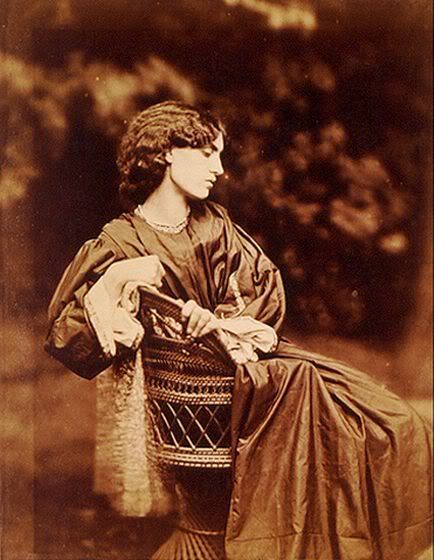
Rossetti wrote the following sonnet to accompany the painting:
Mystery, lo! betwixt the sun and moon
Astarte of the Syrians: Venus Queen
Ere Aphrodite was. In silver sheen
Her twofold girdle clasps the infinite boon
Of bliss whereof the heaven and earth commune:
And from her neck's inclining flower-stem lean
Love-freighted lips and absolute eyes that wean
The pulse of hearts to the sphere's dominant tune.
Torch-bearing, her sweet ministers compel
All thrones of light beyond the sky and sea
The witnesses of Beauty's face to be:
That face, of Love's all-penetrative spell
Amulet, talisman, and oracle,-
Betwixt the sun and moon a mystery.
Source Consulted: Tim Barringer. The Pre-Raphaelites. London: The Everyman Art Library, 1998.
Posted by
Margaret
at
6:56 AM
15
comments
![]()
![]()
Labels: jane morris, pre-raphaelites, rossetti
Monday, August 18, 2008
Possessed: Announcing a New Pre-Raphaelite Musical!
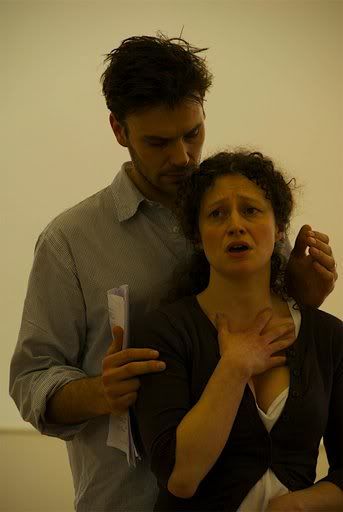
What do you get when you combine Pre-Raphaelite art, an infamous love affair, and music? Possessed is a new musical that examines the life of Jane Burden, from her discovery by Dante Gabriel Rossetti to her meteoric rise to become one of the most popular and iconic models of her age, almost omnipresent in the paintings of the Pre-Raphaelites, particularly those of Dante Gabriel Rossetti. Possessed focuses on the relationship between Jane, her husband William Morris ("Topsy") and Rossetti. The full cast also includes Bessy, the Morris's housekeeper, Lizzie Siddal, Mr. Carter (the foreman of Morris & Co.), and Jane and William Morris’ two daughters, Jenny and May.
Playwright Teresa Howard became inspired to research Jane’s story following a William Morris exhibit at the Victoria and Albert Museum back in 1996. For Possessed, Howard (who has written a number of other plays) has teamed up with composer and arranger Steven Edis, who has written and arranged music for numerous theatre and television productions.
Not surprisingly, art plays a central role in the production. During the course of the musical, stained glass windows depicting the tale of Tristan and Isolde are constructed on stage, symbolising the close relationship between art and life and alluding to the link between the story being played out on stage and the story of Tristan and Isolde.
The musical was presented on April 27 at the Oxford Playhouse and was a great success, generating a great deal of interest in the project. Hopefully full scale production of the musical will begin at the end of next year...I can’t wait!
To learn more about this production, visit the The musical's official website. For up to the minute news and information, visit their blog, Putting it Together.
Rehearsal photo of Anna Francolini as Jane Morris and Joseph Millson as Dante Gabriel Rossetti
Rehearsal Photo by Charles Girdham © 2008, reprinted with permission of Teresa Howard
Posted by
Margaret
at
5:49 AM
6
comments
![]()
![]()
Labels: jane morris, lizzie siddal, music, news, pre-raphaelites, reviews, rossetti, waterhouse, william morris
Tuesday, July 8, 2008
William Morris' La Belle Iseult
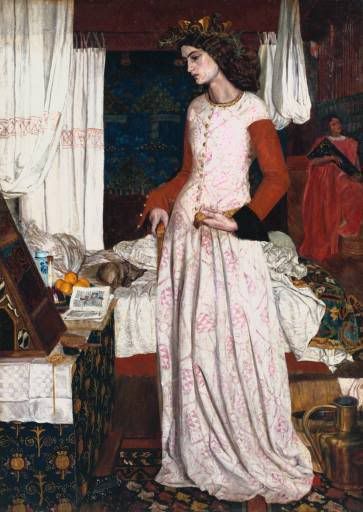
La Belle Iseult is the only painting by William Morris that exists today. The subject of the painting is Tristram's lover Iseult, and it was painted around the same time that his first book of poetry, The Defence of Guenevere , was published. It is probably for this reason that the subject of this painting is often believed to be Guinevere (both date from 1858).
William Morris composed several sketches prior to executing La Belle Iseult. In addition, the painting is believed to be partly inspired by a mural he painted in the Oxford Union in 1957.
The model for the painting is Jane Burden, who married Morris the following year. The work reveals that Morris was not as accomplished in working with oils as his friend Rossetti, as Jane appears rather pale and stiff in this rendering. Morris, who was well aware of his shortcomings as a painter, wrote with charming humility on the canvas, "I cannot paint you, but I love you."
Like many of the Pre-Raphaelite paintings, La Belle Iseult depicts a romanticised vision of the Middle Ages. And while the figures appear a bit uninspired, the textures of textiles the painting are quite striking. This work was finished long before the advent of William Morris' decorating company, but the details evident in the painting, such as the wall, bed and floor coverings--not to mention the lovely pattern on Iseult's dress--all bear witness to Morris' unparalleled talents as a draughtsman and foreshadow his involement in textile design. You will also notice that the book on the nightstand has also been carefully designed.
I adore this work. While Rossetti was much better at capturing the sensuous qualities of Jane and his other models, I think Morris' painting does an incredible job of envisioning a creative, romantic space. It gives one quite the "scope for the imagination"--don't you think?
Source Consulted: The Essential William Morris by Ian Zaczek, p. 16
Photo courtesy of the Tate Gallery
Posted by
Margaret
at
10:30 AM
5
comments
![]()
![]()
Labels: jane morris, medieval, william morris
Saturday, May 3, 2008
William Morris' Daisy Wallpaper
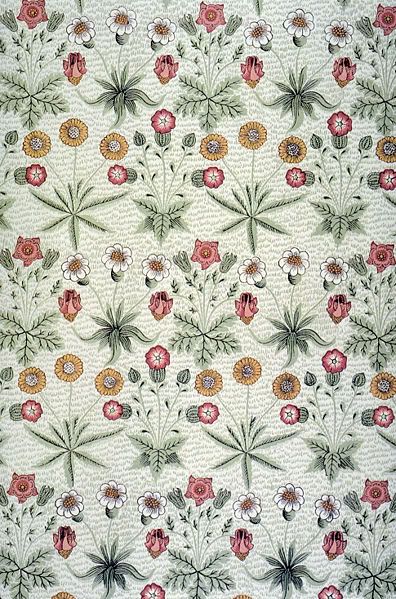
Morris designed both Daisy and Trellis in the early 1860s while he and his family were living at Red House, thought the designs were not officially registered until February 1864. Morris and Company was in its very early stages at that time and so the wallpaper blocks were manufactured for Morris by Jeffrey & Company of Islington, London. The design is made up of four clumps of flowers that are arranged on horizontal lines.
The design for Daisy was inspired either by a daisy wallhanging Jane Morris embroidered, or by an illumination in a medieval manuscript (Froissart's Chronicles)--no-one is absolutely sure.
Whatever the inspiration for the design, it is clear that Morris was influenced by medieval artwork. "Daisy" utilizes some of the medieval design elements discussed by
In "Of Medieval Landscapes" John Ruskin observed that medieval art paid attention to "what was graceful, symmetrical, and bright in colour," and that artists in the Middle Ages tended to reduce the complexity of floral elements to "disciplined and orderly patterns." Daisy demonstrates adhereance to this and other medieval design principles, including the "law of growth" (by showing the buds developing on the plants) and "the law of proportion," which can be seen in the symmetry of the plants (for example, each plant has three flowers and an equal number of leaves).
Personally, I'm not sure what I think about all this symmetry! I love the elements in both "Daisy" and "Trellis," but when they're on a wall it can be a bit overwhelming. I think it's interesting to note that while Morris designed many wallpapers, he used them somewhat sparingly in his own home.
Sources consulted: William Morris Gallery and Writing on the Image: Reading William Morris
Daisy Wallpaper courtesy wikimedia commons
Posted by
Margaret
at
11:35 AM
1 comments
![]()
![]()
Labels: decorating, jane morris, william morris
Friday, May 2, 2008
Rossetti Poem "Genius in Beauty"

While Dante Gabriel Rossetti is best known today for his contribution to Pre-Raphaelite art, in his own day he was celebrated for his poetry. In an interesting twist, his sister Christina Rossetti is now the better known poet in the family--something that would come as a bit of a surprise to both of them if they were alive today!
Dante Gabriel Rossetti's poetry was praised for its passion and drama and he was only 20 years old when his poem "The Blessed Damozel" won critical acclaim.
One of my favourite Rossetti poems is Genius in Beauty, which was published as part of his collection The House of Life in 1870. I suppose I'm comforted by the idea that some beauty cannot by marred by age! I think the poem refers to Jane--I have a hard time picturing Lizzie Siddal as having a "sovereign face" (my apologies, Lizzie lovers!).
Genius in Beauty
Beauty like hers is genius. Not the call
Of Homer's or of Dante's heart sublime, --
Not Michael's hand furrowing the zones of time, --
Is more with compassed mysteries musical;
Nay, not in Spring's Summer's sweet footfall
More gathered gifts exuberant Life bequeaths
Than doth this sovereign face, whose love-spell breathes
Even from its shadowed contour on the wall.
As many men are poets in their youth,
But for one sweet-strung soul the wires prolong
Even through all change the indomitable song;
So in likewise the envenomed years, whose tooth
Rends shallower grace with ruin void of truth,
Upon this beauty's power shall wreak no wrong.
Dante Gabriel Rossetti
Posted by
Margaret
at
7:20 AM
1 comments
![]()
![]()
Labels: jane morris, poetry, pre-raphaelites, rossetti
Monday, April 28, 2008
Spring Fashions Inspired by Art History
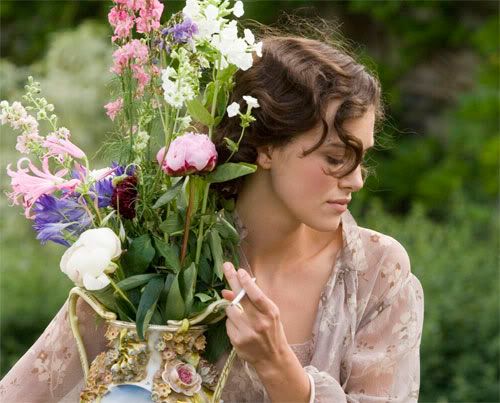
This spring's fashions are inspired by the kind of "romantic freshness" that was prominently displayed in last year's period drama, Atonement (starring Keira Knightly and James McAvoy).
The Spring runways almost always display the year's most feminine fashions, but this year they seem to have stepped it up a notch, with designs that borrow heavilly from the heady romanticism of the Pre-Raphaelites. And I'm not the only one who thinks so!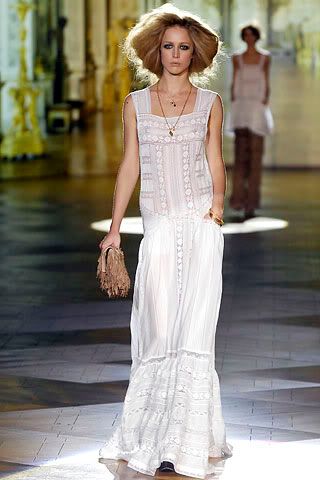 Horacio Silva just wrote a lovely piece for New York Times TMagazine on Jane Morris' contribution to this season's fashions, called The Innocence Project. Be sure and check it out! His discussion of the Pre-Raphaelite's influence on fashion is very interesting, although he does make a factual error (Jane Morris was not a fan of floral prints! Although she enjoyed using them for decorating, she preferred solids, which is amply evident in all of the photographs ever taken of her). The slide show of spring fashions accompanying the article really demonstrates the "turn to the romantic" that designers seem to be taking. Even Roberto Cavalli, who is best known for his plunging necklines and penchant for animal prints has shown a surprising romantic streak this season. This beautiful white lace gown is typical of the soft silhouette and feminine fabrics that Cavalli's utilizing this spring. Note also the Edwardian hairstyles! It looks like this will be a great season to find fearlessly feminine pieces in a variety of fabrics (especially soft floral prints).
Horacio Silva just wrote a lovely piece for New York Times TMagazine on Jane Morris' contribution to this season's fashions, called The Innocence Project. Be sure and check it out! His discussion of the Pre-Raphaelite's influence on fashion is very interesting, although he does make a factual error (Jane Morris was not a fan of floral prints! Although she enjoyed using them for decorating, she preferred solids, which is amply evident in all of the photographs ever taken of her). The slide show of spring fashions accompanying the article really demonstrates the "turn to the romantic" that designers seem to be taking. Even Roberto Cavalli, who is best known for his plunging necklines and penchant for animal prints has shown a surprising romantic streak this season. This beautiful white lace gown is typical of the soft silhouette and feminine fabrics that Cavalli's utilizing this spring. Note also the Edwardian hairstyles! It looks like this will be a great season to find fearlessly feminine pieces in a variety of fabrics (especially soft floral prints).
Posted by
Margaret
at
7:30 AM
6
comments
![]()
![]()
Labels: fashion, jane morris, pre-raphaelites
Wednesday, April 9, 2008
Day Dream by Dante Gabriel Rossetti
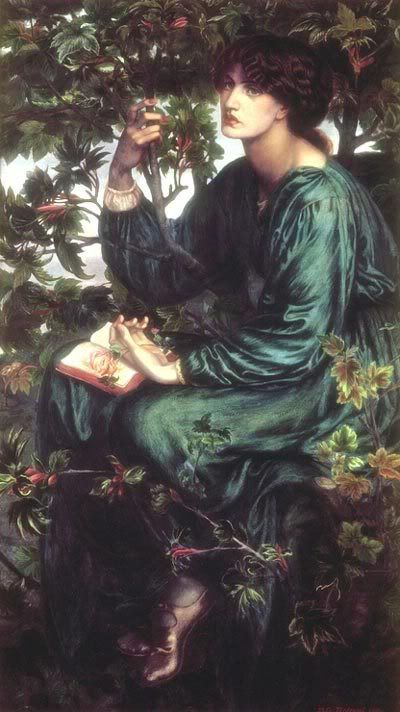
Dante Gabriel Rossetti painted this portrait of Jane Morris, entitled "Day Dream" in 1880. I would have to say that her grasp on the branch is quite provocative. I also love the detail of the leaves on the honeysuckle vine! The painting was accompanied by the following sonnet, which Rossetti inscribed on the frame:
The thronged boughs of the shadowy sycamore
Still bear young leaflets half the summer through;
From when the robin 'gainst the unhidden blue
Perched dark, till now, deep in the leafy core,
The embowered throstle's urgent wood-notes soar
Through summer silence. Still the leaves come new;
Yet never rosy-sheathed as those which drew
Their spiral tongues from spring-buds heretofore.
Within the branching shade of Reverie
Dreams even may spring till autumn; yet none be
Like woman's budding day-dream spirit-fann'd.
Lo! tow'rd deep skies, not deeper than her look,
She dreams; till now on her forgotten book
Drops the forgotten blossom from her hand.
Both the painting and poem were inspired by Tennyson's poem of the same name, The Daydream.
Image courtesy the Victorian and Albert Museum
Posted by
Margaret
at
7:09 AM
1 comments
![]()
![]()
Labels: jane morris, poetry, pre-raphaelites, rossetti
Tuesday, April 1, 2008
Jane Morris and Artistic Dress

Thomas Carlyle once wrote that "society is founded on clothes" and it seems that most social reformers throughout history have agreed. From the long hair sported by hippies in the swinging 60s to the indie fashions of today, clothing has always played a major role in protest. Not surprisingly, clothing also played a leading role in the Pre-Raphaelites vision for a better society. The fashion trend known as "artistic dress" which was popularized by the Pre-Raphaelite models was one of the movement's main legacies.
The movement towards artistic dress can be found in the Pre-Raphaelite's paintings and literature. In Morris' Utopian novel News from Nowhere, the working people are freed from the exploitation of greedy capitalists. One of the first things they do with their freedom is to create beautiful things, including clothing. Their dress is characterised by bright colours, embroidery and handcrafted buckles. The women of Nowhere are "clothed like women, not upholstered like arm-chairs"(53). Because their clothing is not as restrictive, the are able to participated in activities like rowing boats and making hay.
As with their notions about art and architecture, the Pre-Raphaelties weren't content to let their ideas about clothing remain in the art scene. Artistic dress soon became wildly popular in the real world as actresses and other women connected to the art world began imitating the styles sported by Jane Morris and the other Pre-Raphaelite models, such as Lizzie Siddal.
Artistic dress was a reform movement, and was sometimes referred to as "Dress Reform" or the "Rational Dress Movement." Dress reformers were particularly concerned with the restrictiveness of Victorian-era undergarments (especially the corset). As you can see from this painting of Jane Morris, her dresses did not have the extreme "wasp" or "S" shape that was all the rage at the time, and instead featured a more natural silhouette.
As the popularity of artistic dress grew, companies began offering styles that catered to the new trend. Arthur Lasenby Liberty's department store soon became a mecca for followers of the fashion of aesthetic or artistic dress. Liberty specialized in fabrics that appealed to fans of Pre-Raphaelite style and even sold ready-made "artistic" fashions.
Posted by
Margaret
at
8:38 AM
1 comments
![]()
![]()
Labels: fashion, jane morris, pre-raphaelites
Monday, March 31, 2008
Jane Morris and Pre Raphaelite Beauty
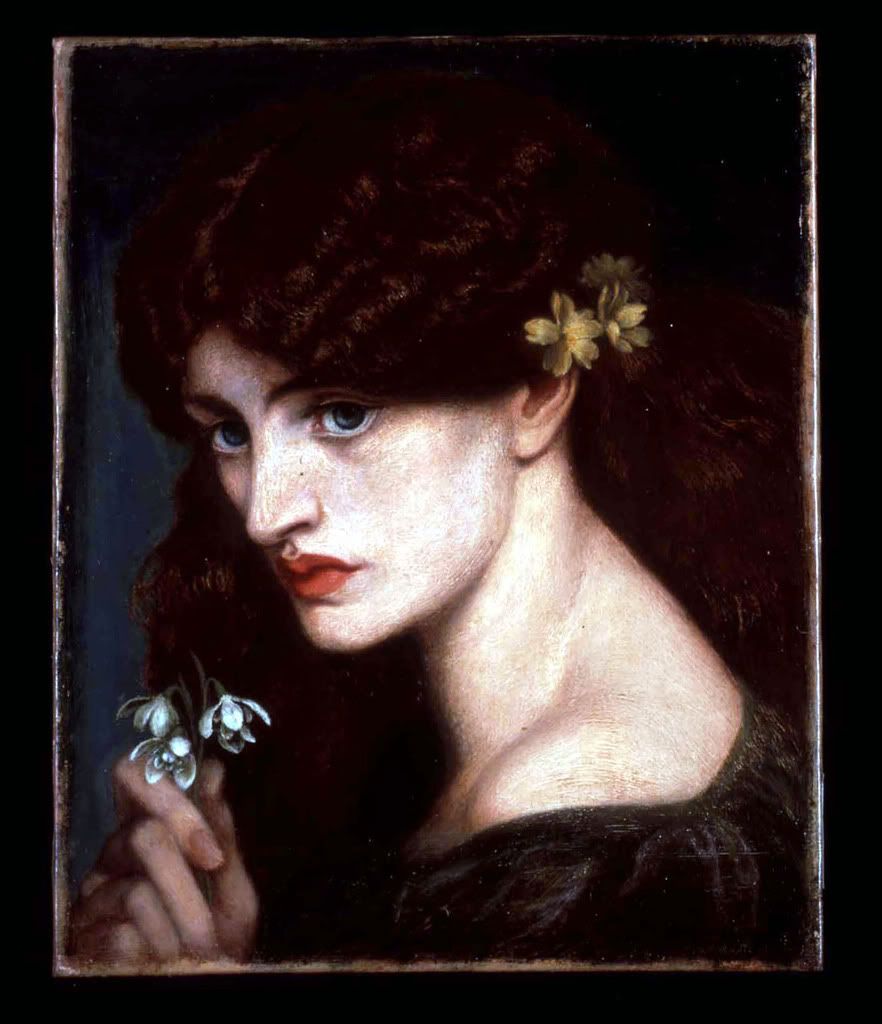
While the Pre-Raphaelite Brotherhood regarded Jane Morris as a "stunner" it took a while for the rest of the world to accept her unusual beauty. In a time where conventional standards of beauty were powerful and unbending, Jane's strong features challenged the norm. Many regard the Pre-Raphaelite models as the first supermodels. They were certainly among the first to popularize a long, lean silhouette in a time when extreme curvaceousness was in vogue.
Jane Morris was a celebrity in the art world, and stories of her rare beauty and delicate constitution seem to have spread like wildfire. When novelist Henry James came to visit the Morris family in 1869, he seems to have been particularly fascinated by Jane and commented extensively on her appearance:
"Imagine a tall lean woman in a long dress of some dead purple stuff, guiltless of hoops (or anything else, I should say), with a mass of crisp black hair heaped into great wavy projections on each side of her temples, a thin pale face, a pair of strange, sad, dark Swinburnian eyes, with great thick black oblique brows, joined in the middle and tucking themselves away under her hair, a mouth like the "Oriana" in our illustrated Tennyson, a long neck, without any collar, and in lieu thereof some dozen strings of outlandish beads"(61-62).
The praise reserved for Jane Morris is rather remarkable. After meeting Jane at Kelmscott House, Bruce Glasier, a Scottish socialist exclaimed:
"I had heard of her great beauty and had seen her portrait in some of the reproductions of Rossetti's pictures, but I confess I felt rather awed as she stood up tall before me, draped in a simple white gown which fell from her shoulders down to her feet. She looked like a veritable Astarte--a being, as I thought, who did not belong to our mortal world"(85).
Of course, Jane Morris' looks did not appeal to everyone, and many were highly critical of her strong features and artistic style of dress. And even fans of the style admitted that it was a welcome fashion trend for women who were not conventionally beautiful. Mary Eliza Haweis, a woman's rights activist, and author of The Art of Beauty and The Art of Dress, confessed that the Pre-Raphaelites were "the plain girl's best friends." She declared that
"Morris, Burne-Jones and others, have made certain types of face, once literally hated, actually the fashion...A pallid face with a protruding lip is highly esteemed. Green eyes, a squint, square eyebrows, whitey-brown complexions are not left out in the cold. In fact, the pink-cheeked dolls are no where; they are said to have "no character" and a pretty little hand is voted characterless too. Now is the time for plain women. Only dress after the Pre-Raphaelite style and you will be astonished to find that so far from being an "ugly duck" you are a full fledged swan"(88-89).
Jane Morris actually reminds me of Audrey Hepburn, in a way. At the time when Audrey Hepburn became a star, voluptuous women were the beauty standard and long, lean women like Hepburn were often regarded as rather plain. Audrey always argued that her look was very "attainable." She once said that "Women can look like Audrey Hepburn by flipping out their hair, buying the large sunglasses, and the little sleeveless dresses.”
Work cited: Debra N. Mancoff. Jane Morris: the Pre-Raphaelite Model of Beauty San Francisco: Pomegrantate, 2000..
Posted by
Margaret
at
9:47 AM
4
comments
![]()
![]()
Labels: fashion, jane morris
Wednesday, February 20, 2008
William Morris and Kelmscott Manor
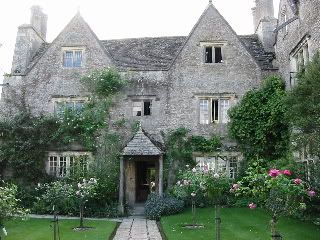
In 1871, William Morris and Dante Gabriel Rossetti signed a joint lease on Kelmscott Manor (not to be confused with Kelmscott House, Morris' home in Hammersmith), a Tudor farmhouse in the village of Kelmscott that had been built in 1571 of of local limestone. Kelmscott became Morris' country house, and is known today by those familiar with the stories of the Pre-Raphaelite circle as the place where Jane Morris and Dante Gabriel Rossetti spent their summers together at the height of their not-so-secret romance.
After signing the lease with Rossetti, Morris wrote his friend Georgiana Burne-Jones:"we have taken a little place deep down in the country...a beautiful and strangely naif house, Elizabethan in appearance...within a stone's throw of the baby Thames, in the most beautiful grey little hamlet called Kelmscott."
In keeping with his belief in preserving ancient buildings, Morris left the house as it was, though he had rotting floor-boards replaced. He and Jane invested a far greater portion of their time in redecorating the interior of the house. The house was filled with art objects from Morris and Company. Morris chose plain white, wool drapes for the drawing room and Jane also painted the walls white. Overall, the decor of the house is simple and elegant and blends seamlessly with the countryside.
Given the complicated nature of living arrangements at Kelmscott, Morris kept himself busy traveling to Iceland during the height of Jane and Rossetti's affair. He and his wife also kept seperate, beautifully decorated bedrooms. Rossetti painted this portrait of Jane, entitled "Water-Willow" after the Willows at Kelmscott, during their first summer together at the Manor, and it hangs in Jane's bedroom above an elaborate jewell casket given to her by Rossetti and Lizzie Siddal as a gift.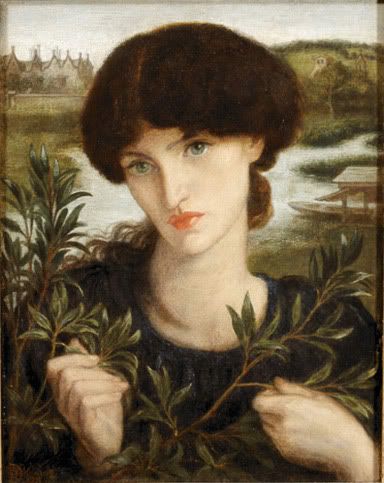
Morris' splendid seventeenth-century oak bed has also become quite famous for the way it was decorated by May and Jane Morris.
The poem "For the Bed at Kelmscott," by Morris is embroidered on the vallance.
The wind's on the wold and the night is a-cold,
And Thames runs chill twixt mead and hill,
But kind and dear is the old house here,
And my heart is warm midst winter's harm.
Rest then and rest, and think of the best
Twixt summer and spring when all birds sing
In the town of the tree, and ye lie in me
And scarce dare move lest earth and its love
Should fade away ere the full of the day.
I am old and have seen many things that have been,
Both grief and peace, and wane and increase.
No tale I tell of ill or well,
But this I say: night treadeth on day,
And for worst and best right good is rest.
If you are interested in visiting Kelmscott, be sure to check out their website!
Posted by
Margaret
at
9:29 AM
5
comments
![]()
![]()
Labels: jane morris, rossetti, william morris
Thursday, January 10, 2008
Photographs of Jane Morris


Pre-Raphaelite Sisterhood has had two days of great posts on Jane Morris, one of my favourite figures of the Pre-Raphaelite movement. Being a Jane Morris fan, I have my own favourite photographs of her that I would like to share.
Posted by
Margaret
at
2:20 PM
3
comments
![]()
![]()
Labels: jane morris, pre-raphaelites, rossetti, william morris


